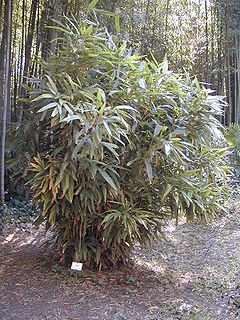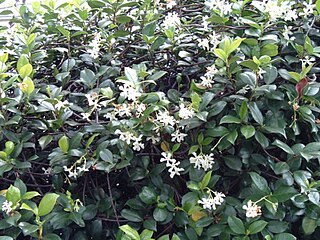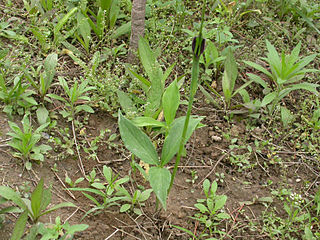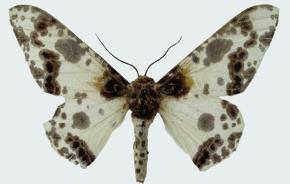
Indocalamus is a genus of about 35 species of flowering plants in the grass family Poaceae, native to China, Vietnam and Japan. They are quite small evergreen bamboos normally up to 2 m (6.6 ft) in height, initially forming clumps and then spreading to form larger thickets. They have thick, glossy leaves.

Adenophora is a genus of flowering plants in the family Campanulaceae, the bellflowers. Plants of this genus are known commonly as ladybells. Most are native to eastern Asia, with a few in Europe. Many are endemic to either China or Siberia.

Osmanthus is a genus of about 30 species of flowering plants in the family Oleaceae. Most of the species are native to eastern Asia with a few species from the Caucasus, New Caledonia, Sumatra, and North America.

Triadica is a plant genus of the family Euphorbiaceae first described as a genus in 1790. It is native to eastern southeastern, and southern Asia.
- Triadica cochinchinensisLour. - China, Cambodia, Assam, Bangladesh, Bhutan, Nepal, Himalayas of E + N India, Borneo, Sulawesi, Sumatra, Laos, Malaysia, Myanmar, Philippines, Thailand, Vietnam
- Triadica rotundifolia(Hemsl.) Esser - Guangdong
- Triadica sebifera(L.) Small - China, Japan; naturalized in Himalayas, Cuba, Puerto Rico, SE + SC USA, Sacramento Valley in N California

TrachelospermumStar Jasmine, Confederate Jasmine, is a genus of evergreen woody vines in the dogbane family Apocynaceae, first described as a genus in 1851. All species are native to southern and eastern Asia.

Rohdea is a genus of native to eastern Asia. It was long thought to contain only a single species, R. japonica, but recent studies have resulted in several other taxa being transferred into the genus.

Pinellia is a genus of plants in the family Araceae native to East Asia. Its species are commonly called green dragons due to the color and shape of the inflorescence, which possesses a green, hooded spathe from which protrudes a long, tongue-like extension of the spadix. The leaves vary greatly in shape among different species, from simple and cordate to compound with three to many leaflets. Pinellia reproduces rapidly from seed and many species also produce bulbils on the leaves. Both characteristics have allowed some species to become weedy in temperate areas outside their native range, notably Pinellia ternata in eastern North America.

The genus Helwingia consists of shrubs native to eastern Asia, the Himalayas, and northern Indochina. It is the only genus in the family Helwingiaceae.

Linnaea is a plant genus in the family Caprifoliaceae. Until 2013, the genus included a single species, Linnaea borealis. In 2013, on the basis of molecular phylogenetic evidence, the genus was expanded to include species formerly placed in Abelia, Diabelia, Dipelta, Kolkwitzia and Vesalea.

Eremochloa is a genus of Asian and Australian plants in the grass family.
- Eremochloa attenuataBuit. - Thailand
- Eremochloa bimaculataHack. - Guizhou, Hubei, Sichuan, Yunnan, Cambodia, Myanmar, New Guinea, Thailand, Vietnam, Queensland, New South Wales, Victoria
- Eremochloa ciliaris(L.) Merr. - Fujian, Guangdong, Guangxi, Guizhou, Hainan, Taiwan, Yunnan, Cambodia, Indonesia, Laos, Malaysia, Myanmar, New Guinea, Philippines, Thailand, Vietnam, Queensland
- Eremochloa ciliatifoliaHack. - Myanmar, Thailand, Vietnam
- Eremochloa eriopodaC.E.Hubb. - Indochina, Sulawesi
- Eremochloa lanceolataBuit. - Thailand
- Eremochloa maxwelliiVeldkamp - Thailand
- Eremochloa muricata(Retz.) Hack. - Guangdong, Myanmar, Thailand, Vietnam, Sri Lanka, Tamil Nadu
- Eremochloa ophiuroides(Munro) Hack. - Anhui, Fujian, Guangdong, Guangxi, Guizhou, Hainan, Henan, Hubei, Hunan, Jiangsu, Jiangxi, Sichuan, Taiwan, Zhejiang, Vietnam
- Eremochloa pectinataBuit. - India, Sri Lanka
- Eremochloa petelotiiMerr. - Thailand, Vietnam, Cambodia
- Eremochloa renvoizeiTraiperm & Boonkerd - Vietnam
- Eremochloa zeylanica(Trimen) Hack. - Yunnan, Guangxi, Sri Lanka, Andaman Islands

Gravitarmata margarotana, the pine cone tortrix or pine twig moth, is a moth of the family Tortricidae. In Europe, it is found from England to Austria and Poland, east to the Baltic region to Russia, China, Korea and Japan.

Biston panterinaria is a moth of the family Geometridae. It is found in China, India, Nepal, Sikkim, Vietnam and Thailand.
Eupoecilia amphimnesta is a species of moth of the family Tortricidae. It is found in China, Taiwan, India, Japan, Korea, Mongolia, Russia and Europe.

Sagittaria pygmaea, commonly known as the dwarf arrowhead or pygmy arrowhead, is an aquatic plant species. It is native to Japan, Korea, Taiwan, Thailand, Vietnam, Bhutan and China.
Disporopsis is a genus of plants in the Agavoideae. It is native to China, Indochina and the Philippines.
- Disporopsis aspersa(Hua) Engl. ex Diels - Guangxi, Hubei, Hunan, Sichuan, Yunnan
- Disporopsis fuscopictaHance - Philippines, Fujian, Guangdong, Guangxi, Guizhou, Hunan, Jiangxi, Sichuan, Yunnan
- Disporopsis jinfushanensisZ.Y.Liu - Sichuan
- Disporopsis longifoliaCraib - Laos, Thailand, Vietnam, Guangxi, Yunnan
- Disporopsis luzoniensis(Merr.) J.M.H.Shaw - Luzon
- Disporopsis pernyi(Hua) Diels - Guangdong, Guangxi, Guizhou, Hunan, Jiangxi, Sichuan, Taiwan, Yunnan, Zhejiang
- Disporopsis undulataTamura & Ogisu - Sichuan
Schnabelia is a genus of plants in the Lamiaceae, first described in 1921. The entire genus is endemic to China.
Mosla is a genus of plants in the Lamiaceae, first described as a genus in 1875. It is native to eastern Asia, the Himalayas, and southeastern Asia.
- Mosla bracteataDoan ex Suddee & A.J.Paton - Vietnam
- Mosla cavalerieiH.Lév.- Vietnam, Guangdong, Guangxi, Guizhou, Hubei, Jiangxi, Sichuan, Yunnan, Zhejiang
- Mosla chinensisMaxim. - Vietnam, Korea, Japan, Anhui, Fujian, Guangdong, Guangxi, Guizhou, Hubei, Hunan, Jiangsu, Jiangxi, Shandong, Sichuan, Taiwan, Zhejiang
- Mosla coreanaH.Lév. - Korea
- Mosla dianthera(Buch.-Ham. ex Roxb.) Maxim. - China, Japan, Korea, Ryukyu Islands, Kuril Islands, Primorye, Caucasus, Himalayas, Myanmar, Vietnam, Philippines, Sumatra
- Mosla exfoliata(C.Y.Wu) C.Y.Wu & H.W.Li - Sichuan
- Mosla hangchouensisMatsuda - Zhejiang
- Mosla japonica(Benth. ex Oliv.) Maxim. - Japan, Korea, Ryukyu Islands
- Mosla longibracteata(C.Y.Wu & S.J.Hsuan) C.Y.Wu & H.W.Li - Guangxi, Zhejiang
- Mosla longispica(C.Y.Wu) C.Y.Wu & H.W.Li - Jiangxi
- Mosla pauciflora(C.Y.Wu) C.Y.Wu & H.W.Li - Guizhou, Hubei, Sichuan
- Mosla punctulataNakai - Korea, Taiwan, Japan, China
- Mosla scabra(Thunb.) C.Y.Wu & H.W.Li - Vietnam, Korea, Japan, Ryukyu Islands, Anhui, Fujian, Gansu, Guangdong, Guangxi, Henan, Hubei, Hunan, Jiangsu, Jiangxi, Liaoning, Shaanxi, Sichuan, Taiwan, Zhejiang
- Mosla soochouensisMatsuda - Anhui, Jiangsu, Jiangxi, Zhejiang
- Mosla tamdaoensisPhuong - Vietnam

Acer amplum is an Asian species of maple found in Vietnam and China.
Acer cordatum is an Asian species of maple. It has been found only in China.
















